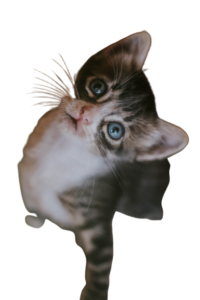If you and your cat are not bonding, perhaps it is because you are not effectively communicating with them.
There’s no need to worry, as research conducted in recent time has revealed that it isn’t as challenging as it may seem. All you have to do is communicate with cats by smiling at them differently. Instead of showing your teeth like humans do, try narrowing your eyes and blinking slowly.
Scientists have validated that by studying the way cats and humans interact; they have established that this behavior encourages cats to feel both comfortable and curious, leading them to be more open to human interaction.
In a statement from 2020, Karen McComb, a psychologist from the University of Sussex, expressed her delight in demonstrating that cats and humans can engage in this form of communication, drawing on her background in animal behavior studies and personal experience as a cat owner.
The discovery of evidence confirming that many cat owners had suspected is thrilling, as it pertains to their ability to communicate and understand what to do.
If you have had any experience with cats, chances are you have witnessed their facial expressions of ‘partially closed eyes’ along with slow blinking. This behavior is comparable to the way human eyes narrow when smiling and typically happens when the feline is in a state of relaxation and happiness. This expression is commonly understood as a form of communication resembling a cat’s version of a smile.
Cat owners have shared anecdotal evidence suggesting that humans can mimic this expression to signal friendliness and willingness to engage with cats. In order to investigate if cats respond differently to humans who engage in slow blinking, a group of psychologists conducted two experiments.
During the initial trial, 21 cats from 14 different households were subjected to slow-blinking by their owners. The owners were directed to position themselves approximately 1 meter away from their settled and content cats in a familiar home setting and to slow-blink when the feline was making eye contact. The entire process was captured on cameras, which recorded the facial expressions of both the owners and their cats. Later, the findings were contrasted with the blinking behavior of cats in the absence of any human involvement.
The findings indicated that cats are more inclined to engage in slow-blinking with their humans when their humans initiate the slow-blinking interaction, as opposed to no interaction at all.
In the second trial, a total of 24 cats from eight distinct households were involved. In this instance, instead of the owners, it was the researchers who performed the blinking action. It is important to note that these researchers had not previously interacted with the cats. As part of a control group, the cats’ reactions were recorded under a no blink situation where humans gazed at them without blinking.
The scientists replicated the initial experiment by engaging in the same slow blink procedure, while also extending their hand towards the cat. Surprisingly, they observed that not only did the cats respond with reciprocal blinking more frequently, but they also displayed an increased tendency to approach the human’s hand following the blink.
McComb stated that this study is the initial one to conduct experimental research on the significance of slow blinking in the communication between cats and humans.




You can experiment with this technique both at home with your own cat and when encountering cats on the street. It’s an excellent method to strengthen the connection you share with felines. Attempt to look for squinting at them, mimicking a relaxed smile, and then briefly closing your eyes. You will notice that they reciprocate the same behavior, allowing you to initiate a form of communication.
While dogs may display more enthusiasm in their demonstrations compared to cats, this revelation should come as no surprise to cat enthusiasts. Recent research has revealed that our feline companions are surprisingly attuned to their human counterparts and comparing them to dogs would be unfair.
Cats are known for their independent and discerning nature, so it’s essential to understand that their behavior is often a reflection of how we interact with them. If you find yourself encountering cats that appear aloof or uninterested, taking a closer look at your own behavior can help foster a better connection with these enigmatic creatures.
Firstly, it’s important to approach cats with patience and respect. Unlike dogs who may readily seek attention, cats prefer to set the pace in establishing relationships. Similarly, cats tend to mirror the characteristics of their human companions, which could explain why they appear to sense when their owners are feeling down. Although they often choose to disregard their names, cats do possess the ability to recognize them. It is remarkable how profound the connections between cats and their owners can be.
The reason behind why cats engage in slow blinking at humans remains a mystery. This behavior has been interpreted as a way of conveying non-threatening intentions, as cats perceive prolonged staring as a threat. However, it is also plausible that cats have developed this expression because humans respond favorably to it. Determining the exact motive behind this communication technique in domesticated animals is often challenging.
Regardless of the approach, it appears to facilitate the development of a connection. This knowledge is valuable as it suggests that enhancing our bond with these mysterious creatures could enhance their emotional well-being, not only within domestic settings but also in various potentially challenging circumstances.
Psychologist Tasmin Humphrey of the University of Sussex emphasized that gaining knowledge about the positive ways cats and humans interact can contribute to a better understanding of cats, promote their well-being, and provide insights into the socio-cognitive abilities of this species that has received limited attention in research.
The most valuable information which we have gathered has the potential to be utilized in various environments, such as veterinary clinics and animal shelters, to evaluate the well-being of cats.
Are you planning to give it a shot at this very moment? More specifically, will you attempt to communicate with your cat? If so, let’s explore how you can successfully engage in feline dialogue. When connecting with your furry companion, it’s essential to approach the interaction with patience and a gentle demeanor. Begin by observing your cat’s body language to gauge their interest and level of comfort. To effectively communicate, maintain eye contact while softly speaking or using soothing sounds. Additionally, creating an inviting environment enriched with toys and treats can help establish rapport. Remember, building a strong bond takes time and effort; be prepared for gradual progress rather than immediate results!